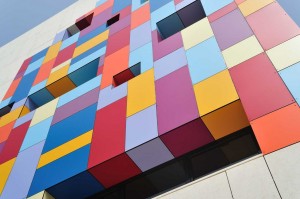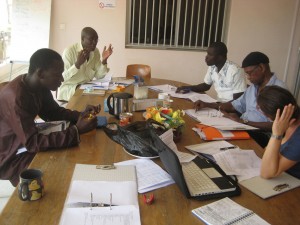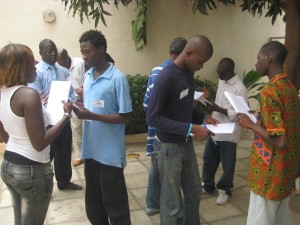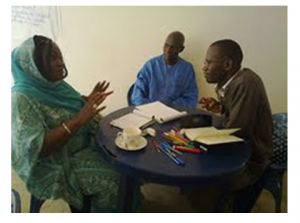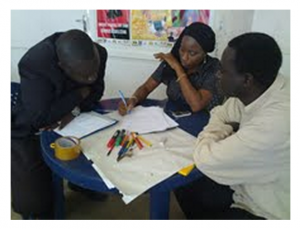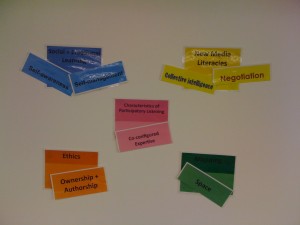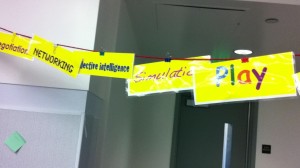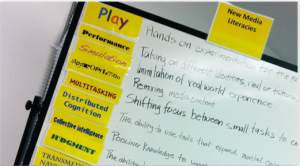In 2009, I began examining the intersections between new media literacies (NMLs; Jenkins, Clinton, Purushotma, Weigel, & Robison, 2006) and social and emotional learning skills (SELs; Collaborative for Academic, Social, and Emotional Learning, n.d.). I was a student in Dr. Henry Jenkins’s first seminar at USC, and the final paper was looming. I had recently been introduced, via Dr. Michael Cody, to Alexandre Rideau, the director of Senegal’s non-profit Reseau Africain d’Education pour la Sante (RAES) (or, in English, the African Network for Health Education). Alex wanted a proposal for revamping his youth communication for social change program, Sunukaddu. So I completed my assignment in Henry’s class by pitching a NML-rich modification to Sunukaddu for Alex, and adding in the dimension of SEL, which happens to be my passion.
Felt, L.J. (2009). Participatory learning methodologies for enriching an HIV/AIDS intervention to Senegalese youth: The Case for social and emotional learning and new media literacies. Unpublished manuscript.
Both boys bought it, and two important, collaborative relationships were born.
In terms of Alex and Sunukaddu… During the summer of 2010, I traveled to Senegal and spent two months co-designing and implementing Sunukaddu 2.0 with a group of extraordinary colleagues: Idrissa, Tidiane, Charles, and Amadou. Later, Brock also joined our brigade.
There was innovation on the educator level.
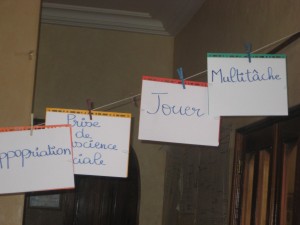
There was learning on the participant level.
Among both populations post-intervention, growth and advancement:
“You gave me self-confidence thanks to these skills” (Educator Tidiane Thiang, personal communication, September 22, 2010).
“…I saw [Sunukaddu participant] Mami who told me that she’s working in a retail establishment right now and [Sunukaddu participant] Azoupi is enrolled in a computer graphics workshop to become an editor. So, the training awakened vocational interests but also gave youths courage, the courage to take their destinies in their own hands” (Educator Tidiane Thiang, personal communication, October 18, 2010).
And on the communicative/scholarly level, a fair number of works produced (NOTE: The following list just details my efforts, not the textual, multimedia, and programmatic products developed by RAES):
PUBLICATIONS
Felt, L.J., Dura, L., & Singhal, A. (in press). Cultural Beacons in health communication: Leveraging overlooked indicators and grassroots wisdoms. In D.K. Kim, G. Kreps, & A. Singhal (Eds.), Global Health Communication Strategies in the 21st Century. New York: Peter Lang Publishing Group.
Felt, L.J. & Rideau, A. (2012). Our Voice: Public Health and Youths’ Communication for Social Change in Senegal. In M.O. Ensor (Ed.), African Childhoods: Education, Development, Peacebuilding, and the Youngest Continent (pp. 201-217). New York: Palgrave MacMillan.
Felt, L.J. (2010, July 29). Making education (double) count: Boosting student learning via social and emotional learning and new media literacy skills. eLearn Magazine: Education and Technology in Perspective.
PRESENTATIONS
Dura, L., Felt, L.J. & Singhal, A. (June 18, 2013). Cultural beacons: Grassroots indicators of change. Paper presented at 63rd Annual International Communication Association Conference, London, UK.
Felt, L.J. (March 15, 2013). Our Voice: Youths’ Meaningful Communication for Social Change in Sénégal. 4th Annual Digital Media & Learning Conference. Chicago, IL.
Singhal, A., Dura, L., & Felt, L.J. (November 19, 2011). What counts? For whom? Valuing cultural scorecards. Paper presented at 97th Annual National Communication Association Conference, New Orleans, LA.
Felt, L.J. (November 16, 2010). Leveraging new media literacies & social & emotional learning to enrich teen education in Senegal. Paper presented at 96th Annual National Communication Association Conference, San Francisco, CA.
Felt, L.J. (April 30, 2010). Can social and emotional learning and new media literacies SAVE THE WORLD (or at least pedagogy)?: Participatory learning in an HIV/AIDS intervention to Senegalese adolescents. 2nd Annual Annenberg Fellows Symposium. Los Angeles, CA.
Felt, L.J., Literat, I., & Morgan, M. (November 18, 2010). New Media Literacies: The core challenges of implementation and assessment in international contexts. Global Education Conference. Elluminate.com.
Felt, L.J. (2010, October 14). Our voices: Communication and collaboration from the inside out. Presentation at USC Annenberg School for Communication & Journalism Dean’s Forum: Fostering Community for Robert F. Kennedy’s Legacy in Action. Los Angeles, CA.
BLOG POSTS
- July 7, 2012: Tidiane, or Sunukaddu at T3
- April 10, 2012: Pecha Kuchas at USC Annenberg Dean’s Forum
- April 2, 2011: Boundary Work: Jumping Barriers and Supporting Segregation
- December 9, 2010: Sincere: Sunukaddu
- September 1, 2010: High Tech? Low Tech? No Tech?
- August 25, 2010: Sunukaddu — A Voice for Youth in Senegal
- August 4, 2010: What is Sunukaddu?
- July 29, 2010: Making Education (Double) Count
- June 24, 2010: SENEGAL: Assessment
MULTIMEDIA
Examples of NMLs and SELs at Sunukaddu
Explanation of NMLs with Clips of Sunukaddu
Since that time, Alex and our RAES colleagues have utilized the “Sunukaddu method” for a training with youth outreach professionals.
According to Alex (personal communication, December 19, 2012), “sunukaddu is spreading in Africa : Mali, guinea, burkina, Niger, Benin… And hopefully Gabon soon !” About a month later, Alex dropped me another line (personal communication, January 17, 2013):
Hey Laurel,
We are remolding the curriculum for scale up. We would like it to be based on NML & SEL competencies… but feel there are too many of them and wish to group some of them…. have you ever started working on something like this ? Any idea ? Any doc to share with us ?
Thanks for your help!
Cheers,
Alex
And as a matter of fact, I did.
Back at MIT, years before I joined Project New Media Literacies, the research group worked with Harvard’s GoodPlay Project on a publication called Our Space: Being a Responsible Citizen of the Digital World. This resource identifies five areas in which to practice digital citizenship: Participation, Identity, Credibility, Privacy, and Ownership and Authorship.
It also contends that proficiency in a subset of ethical thinking skills – namely, perspective-taking, reflecting on one’s roles and responsibilities, and considering potential benefit and harm to communities – facilitates digital citizenship: “If youth engage these skills, we believe they will be more likely to behave as, and conceive of themselves as, responsible citizens—as opposed to simply bystanders or (at worst) abusers—of online communities” (p. 2).
Fast forward to January of 2011. My Project New Media Literacies colleagues Vanessa Vartabedian, Erin Reilly, and I sketched out a framework for an after-school program in digital citizenship. A scant few weeks later, we began implementing this program for high schoolers at the Robert F. Kennedy Community Schools.
Our framework was ambitious — arguably, overly ambitious. We drew from 5 discrete skill sets: NMLs, SELs, ethics, mapping, and Characteristics of Participatory Learning (CPLs; later termed Principles of Participatory Learning in Shall we play? (Reilly, Jenkins, Felt, & Vartabedian, 2012)).
Remember, these are skill SETS — which means that each set has its own fleet of skills. NMLs = 12 skills. SELs = 5 skills. Ethics = 5 skills. Mapping = 5 skills. CPLs = 5 skills. TOTAL: 32 skills. That’s a lot of skills. To put it mildly.
Each lesson plan in our program enumerated at least 1 skill from each skill set that the day’s activities addressed; since there were 5 skill sets, each lesson was to address at least 5 skills. I truly believe that the day’s activities did address them. But NMLs (and, to a lesser extent, SELs) were our comfort zone. So, in practice, they were our focus.
For example, we hung a Sunukaddu-esque clothesline of NML skills in our classroom.
We asked students to define the NMLs in their own words.
The pre- and post-surveys that we administered (whose significance were nil, but perhaps primed participants to our values and expectations) investigated NMLs and SELs.
To review, our program purported to impact digital citizenship; we concentrated on NMLs and SELs. So, I pondered as I wrote up our results, how do NMLs and SELs relate to digital citizenship?
I wrote, “Our understanding of digital citizenship follows these authors’ [GoodPlay Project and Project New Media Literacies] framing; specifically, respecting the impact of one’s actions beyond the self on the larger collective is the cornerstone of digital citizenship.”
Then I thought about the meaning of the publication’s three ethical thinking skills: perspective-taking, reflecting on one’s roles and responsibilities, and considering potential benefit and harm to communities. What is perspective-taking? Reflecting on one’s roles and responsibilities? Considering potential benefit and harm to communities? I realized that I could define these three ethical thinking skills in terms of NMLs and SELs.
The piece got published.
Felt, L.J., Vartabedian, V., Literat, I., & Mehta, R. (2012). Explore Locally, Excel Digitally: A Participatory Learning After-school Program for Enriching Citizenship On- and Offline. Journal of Media Literacy Education, 4(3), pp. 213-228.
Here’s what we purported:
The ethical thinking skill of perspective-taking is equivalent to the NML skill of performance plus the SEL skill of social awareness. Reflecting on one’s roles and responsibilities is equivalent to the NML skill of collective intelligence plus the SEL skill of self-awareness. Considering potential benefit and harm to communities is equivalent to the NML skill of negotiation plus the SEL skill of responsible decision-making (Felt et al., 2012, p. 219).
Alex’s email inspired me. I revised my formulation on January 18, 2013, adding an additional SEL skill to the sum of each ethical thinking skill — that is, each ethical thinking skill equaled 1 NML + 2 SELs. I believe this more completely and accurately reflects the meaning of each ethical thinking skill.
1. Perspective-taking = Performance (NML) + Self-management, Social awareness (SELs)
My Definition: Adopting alternative identities through embracing the perspective of and empathizing with others for the purpose of improvisation and discovery.
2. Reflection on roles and responsibilities = Collective intelligence (NML) + Self awareness, Social awareness (SELs)
My Definition: Recognizing family, school, and community members and institutions as resources, pooling knowledge and comparing notes with others, working cooperatively toward a common goal within the context of healthy, rewarding relationships.
3. Consideration of potential benefit and harm to communities = Negotiation (NML) + Social awareness, Responsible decision-making (SELs)
My Definition: Interacting with diverse communities, discerning, respecting, and being able to take on multiple perspectives, recognizing and appreciating individual and group similarities and differences, grasping and following appropriate (possibly alternative) social norms, and contributing to the well-being of the community.
I told Alex in an email dated 22 January 13 that I believe this approach could simplify Sunukaddu’s curriculum. By highlighting the three ethical thinking skills of digital citizenship, they also get at 3 important NMLs and all 5 of the SELs.
I also presented to Alex a second skill composite list.
Back story: In 2011, Vanessa, Erin, Henry and I planned Summer Sandbox, a five-day professional development workshop in participatory learning for Los Angeles Unified School District educators. Like Sunukaddu, this experience (and its companion program, an extension called PLAYing Outside the box) also yielded a fair number of products:
PUBLICATIONS
Reilly, E., Jenkins, H., Felt, L.J., & Vartabedian, V. (2012). Shall we play? Los Angeles, CA: Annenberg Innovation Lab at the University of Southern California.
Reilly, E., Vartabedian, V., Felt, L.J., & Jenkins, H. (2012). PLAY! (Participatory Learning And You!). Los Angeles, CA: Annenberg Innovation Lab at the University of Southern California.
Vartabedian, V. and Felt, L.J. (2012). PLAY! (Participatory Learning and You!) Pilot: Professional Development with Los Angeles Unified School District Educators (LAUSD), Grades 6-12. In E. Reilly and I. Literat (Eds.), Designing with Teachers: Participatory Approaches to Professional Development in Education (pp. 49-66). Los Angeles, CA: Annenberg School for Communication & Journalism.
PRESENTATIONS
Brennan, K., Felt, L.J., Garcia, A., Hickey, D.T., Kirn, S., Literat, I., & E. Reilly. (March 16, 2013). Designing with Teachers: Participatory Approaches to Professional Development in Education. 4th Annual Digital Media & Learning Conference. Chicago, IL.
Reilly, E., Literat, I., Watkins, S.C. Felt, L.J., Kirn, S. & S. Morrisseau. (2012, November 1). Designing With Teachers: Participatory Professional Development. Webinar panelist on connectedlearning.tv.
Felt, L.J. (2012, March 31). Experimenting with Participatory Cultures: The PLAYground. Demonstration at USC Annenberg School for Communication & Journalism’s First Annual Annenberg Innovation Lab Summit. Los Angeles, CA.
Jenkins, H., Reilly, E., Vartabedian, V., Felt, L.J., Carthew, K. & A. Khan. (March 1, 2012). Challenge-based learning and the PLAYground: What is challenge-based learning and how can we use an online platform to explore it? 3rd Annual Digital Media & Learning Conference. San Francisco, CA.
Powerpoint of results of PLAYing Outside the Box mid-point evaluation
Powerpoint of results of Summer Sandbox pre-survey
Felt, L.J. & Schrock, A. (April 15, 2011). PLAY! Participatory Learning And You! 3rd Annual Annenberg Fellows Symposium. Los Angeles, CA.
Vartabedian, V., Felt, L.J., Literat, I., Schrock, A., & Klosterman, M. (March 3, 2011). Characteristics of participatory learning. 2nd Annual Digital Media & Learning Conference. Long Beach, CA.
BLOG POSTS
- November 2, 2012: Participatory Professional Development
- October 2, 2012: The Power and Importance of Play
- June 6, 2012: Most Significant Change
- April 6, 2012: Annenberg Innovation Lab Summit
MULTIMEDIA
PLAY: An Introduction (by Christopher Communications)
Summer Sandbox (by Erickson Raif)
But I digress.
Day One of Summer Sandbox included an “Introduction to New Media Literacies” segment. Vanessa, Erin, and I had decided that we would each set up a station and present 2 NML skills, and then another 2 NML skills. So we paired the 12 NML skills, making 6 pairs. While we tried to pair similar skills, our first objective was to claim our “favorites,” so the pairings were less elegant than perhaps they could have been. I made two revisions on January 18 to address that issue, attempting to improve on the intuitiveness of the pairings. Then, looking over the pairs, I identified what concept the pair covered and titled the pair.
Here is the list:
Dynamic Discovery
Concept: Creativity, de-centering from assumptions (routine, self) in order to make discoveries, gain insight
Play— the capacity to experiment with one’s surroundings as a form of problem-solving.
Performance— the ability to adopt alternative identities for the purpose of improvisation and discovery.
Idea Translation
Concept: Transforming ideas and possibilities into more easily digestible representations
Simulation— the ability to interpret and construct dynamic models of real-world processes.
Visualization— the ability to translate information into visual models and understand the information that visual models communicate
Intellectual Tool Use
Concept: Getting better information or processing better by interacting with objects (e.g., paper & pencil, computer) or entities (e.g., FB community, forum) and demanding/sharing the task
Distributed Cognition— the ability to interact meaningfully with tools that expand mental capacities.
Collective Intelligence— the ability to pool knowledge and compare notes with others toward a common goal.
Multimedia Mastery
Concept: Using media wisely, being familiar with multiple artifacts and types of media, being able to follow a story and tell a story using several pieces of media
Appropriation— the ability to meaningfully sample and remix media content.
Transmedia Navigation— the ability to follow the flow of stories and information across multiple modalities.
Efficient Operation
Concept: Making the most out of time and information, optimizing your efficiency and credibility, showing proper respect of other people’s work and time
Judgment— the ability to evaluate the reliability and credibility of different information sources.
Multitasking— the ability to scan one’s environment and shift focus as needed to salient details.
Network Negotiation
Concept: Working together, respecting differences and leveraging the unique assets that diverse individuals have to offer
Networking— the ability to search for, synthesize, and disseminate information.
Negotiation— the ability to travel across diverse communities, discerning and respecting multiple perspectives, and grasping and following alternative norms.
So there’s composite list #2. I think it might be less useful for Alex’s purpose because it’s longer (6 hybrid NMLs vs 3 ethical thinking skills) and omits the explicit mention of SELs. But I wonder if I could now combine the two lists… What happens if I identify the hybrid NML (rather than the base NML) in the ethical thinking skill formula?
1. Perspective-taking = Performance (NML) + Self-management, Social awareness (SELs)
Performance + Play = Dynamic Discovery
–> Perspective-taking = Dynamic Discovery + Self-management, Social awareness
2. Reflection on roles and responsibilities = Collective intelligence (NML) + Self awareness, Social awareness
Collective intelligence + Distributed cognition = Intellectual Tool Use
–> Reflection on roles and responsibilities = Intellectual Tool Use + Self awareness, Social awareness
3. Consideration of potential benefit and harm to communities = Negotiation (NML) + Social awareness, Responsible decision-making (SELs)
Negotiation + Networking = Network Negotiation
–> Consideration of potential benefit and harm to communities = Network Negotiation + Social awareness, Responsible decision-making
This interpretation identifies 3 core ethical thinking skills and embeds 6 NMLs and 5 SELs. That seems like pretty good bang for your buck.
I’d love to get comments on this work — both list #1, list #2, and their fusion which is list #3. Thank you for bearing with me, and thanks for your thoughts!
P.S. Conversation with Henry Jenkins, January 28, 2013:
Henry reviewed my lists and approved. In terms of the Sunukaddu context, and aiming to deliver all of the skills that pertained to “playing nicely together,” Henry keenly felt the absence of NML appropriation. So, he suggested pairing it with collective intelligence, a NML that also honors the concept of building on each other’s ideas. This left transmedia navigation and distributed cognition as a pair, whose commonalities, I suggested, had to do with deep thinking and managing information in various formats. We didn’t title either pair [and in terms of titles, Henry questioned the title Intellectual Tool Use], so I’m to blame for these appellations:
Idea Engagement
Concept: How we build on each other’s ideas (which is important to consider in terms of ethics), drawing from a pool of public information and meaningfully+ethically contributing or sampling
Collective Intelligence + Appropriation
Resource Navigation
Concept: Dealing with interfaces, intellectual/thinking-oriented, utilizing/combining multiple resources, arriving at more rich/diverse/complex answers the more you create these layers
Transmedia Navigation + Distributed Cognition
So, to edit the previous framework with this update:
1. Perspective-taking = Performance (NML) + Self-management, Social awareness (SELs)
Performance + Play = Dynamic Discovery
–> Perspective-taking = Dynamic Discovery + Self-management, Social awareness
2. Reflection on roles and responsibilities = Collective intelligence (NML) + Self awareness, Social awareness
Collective intelligence + Appropriation = Idea Engagement
–> Reflection on roles and responsibilities = Idea Engagement + Self awareness, Social awareness
3. Consideration of potential benefit and harm to communities = Negotiation (NML) + Social awareness, Responsible decision-making (SELs)
Negotiation + Networking = Network Negotiation
–> Consideration of potential benefit and harm to communities = Network Negotiation + Social awareness, Responsible decision-making
This omits Idea Translation (simulation, visualization), Efficient Operation (judgment, multitasking), and Resource Navigation (transmedia navigation, distributed cognition) from the explicit Sunukaddu curriculum. Such a loss might be rationalized as acceptable, however, if the aim is to concentrate on the skills that focus most on social harmony/civics.
Henry and I also discussed the Senegalese context specifically. He owned that the NMLs were conceived of by Western researchers, thinking about Western youths engaging in high tech practices. As such, are they 100% apt for export and adoption? Or do our Senegalese counterparts need to do some sort of modding and appropriation in order to improve their goodness of fit?
Q: Is this the right, complete framework in Senegal without recognizing the skills that have developed bottom-up? Which skills might we be missing or might map into this network in a new way?
Sense of gift economies and social reciprocity, storytelling tradition and dynamic use of music/dance/fabric, etc…
The Sunukaddu educators and students seemed to enjoy the skills and took great pride in claiming mastery in certain select skills at the end of the program. Tidiane wrote:
“My favorite skills are negotiation, self-awareness, and social awareness because they represent values that are and must be the basis for an equitable and responsible society” (personal communication, September 27, 2010).
And Alex asked for fewer skills, not different/more culturally apt skills. So all of this leads me to believe that, despite the Western context in which these skills were identified, their utility extends to the Global South.


